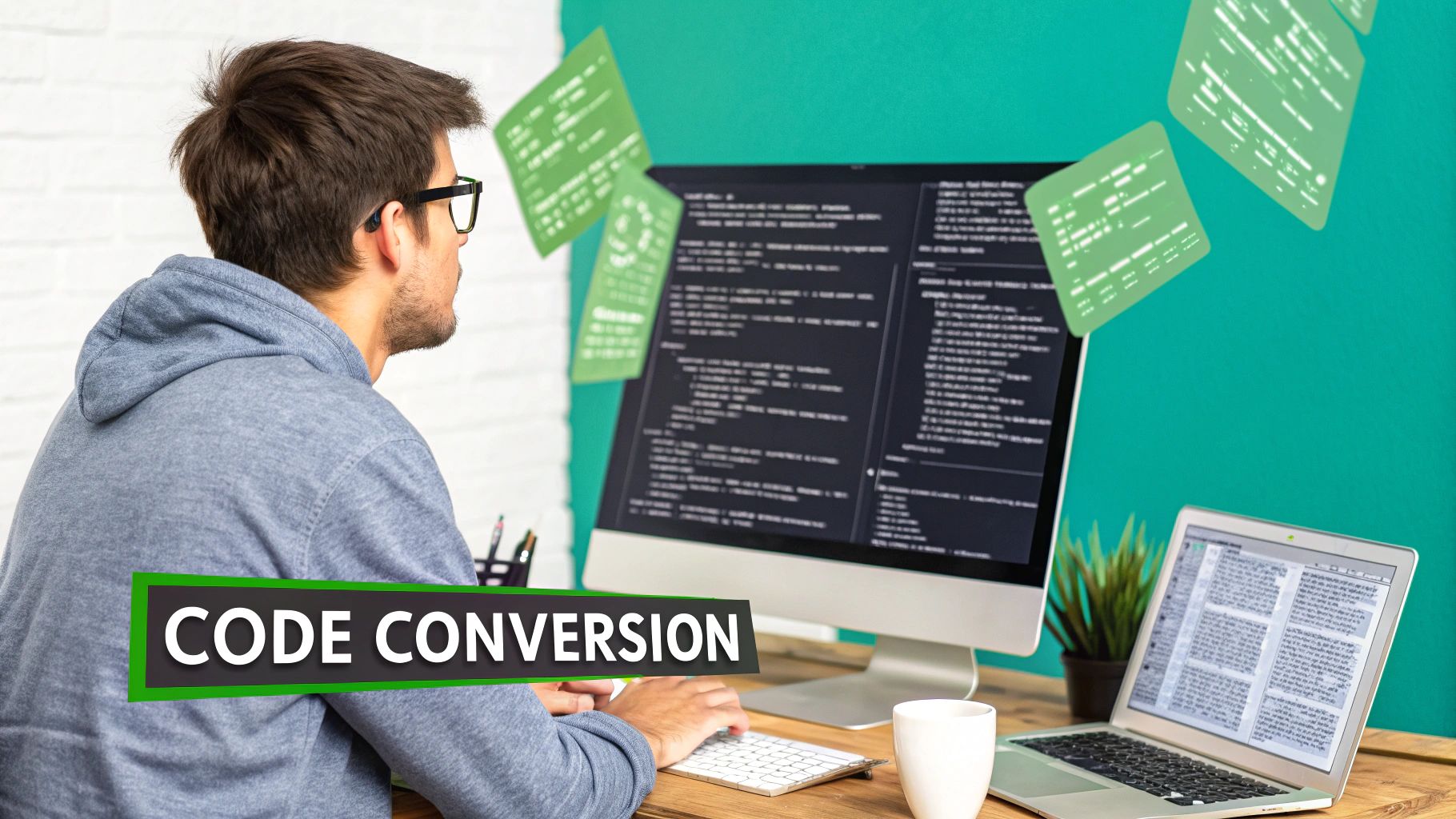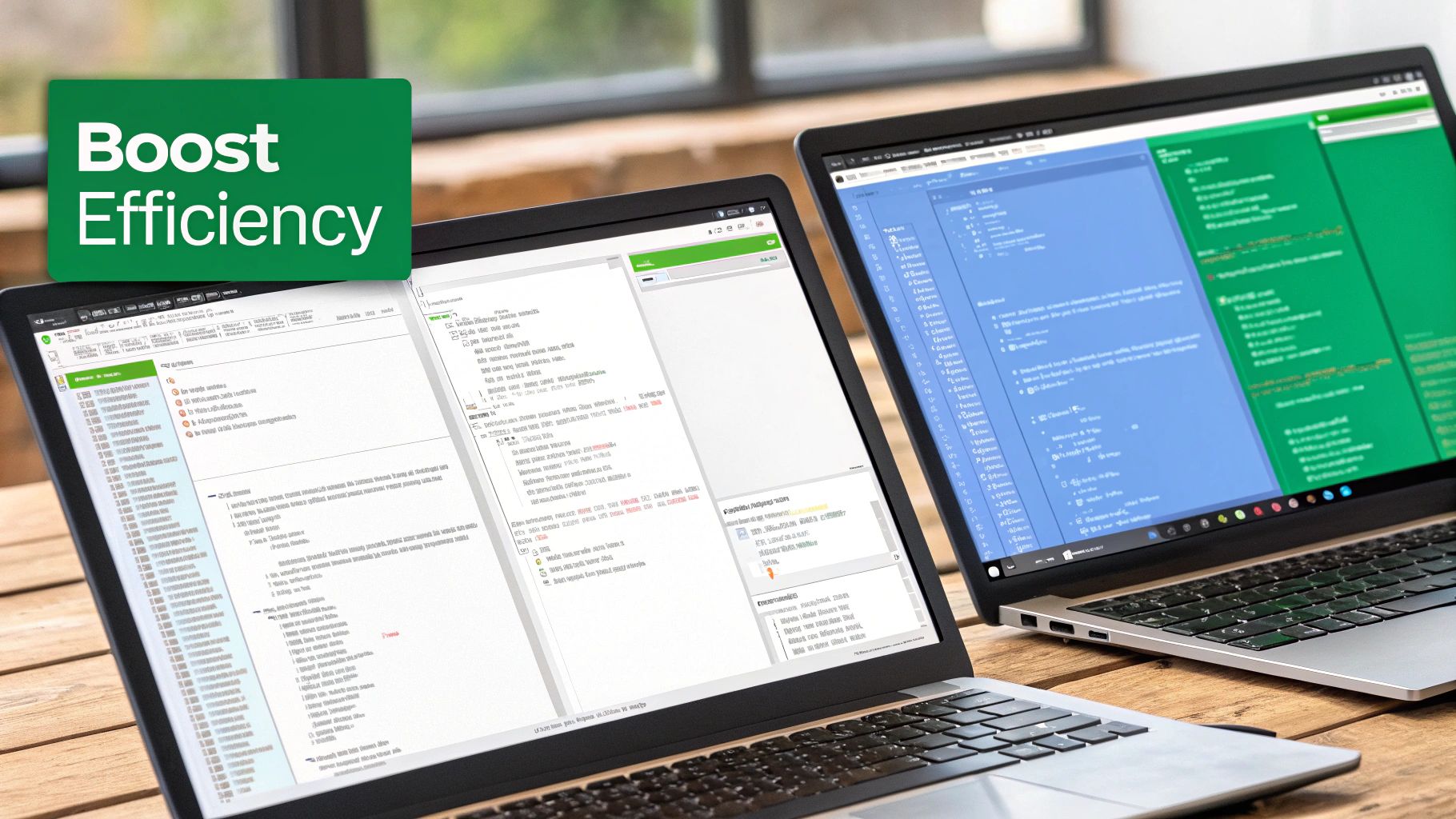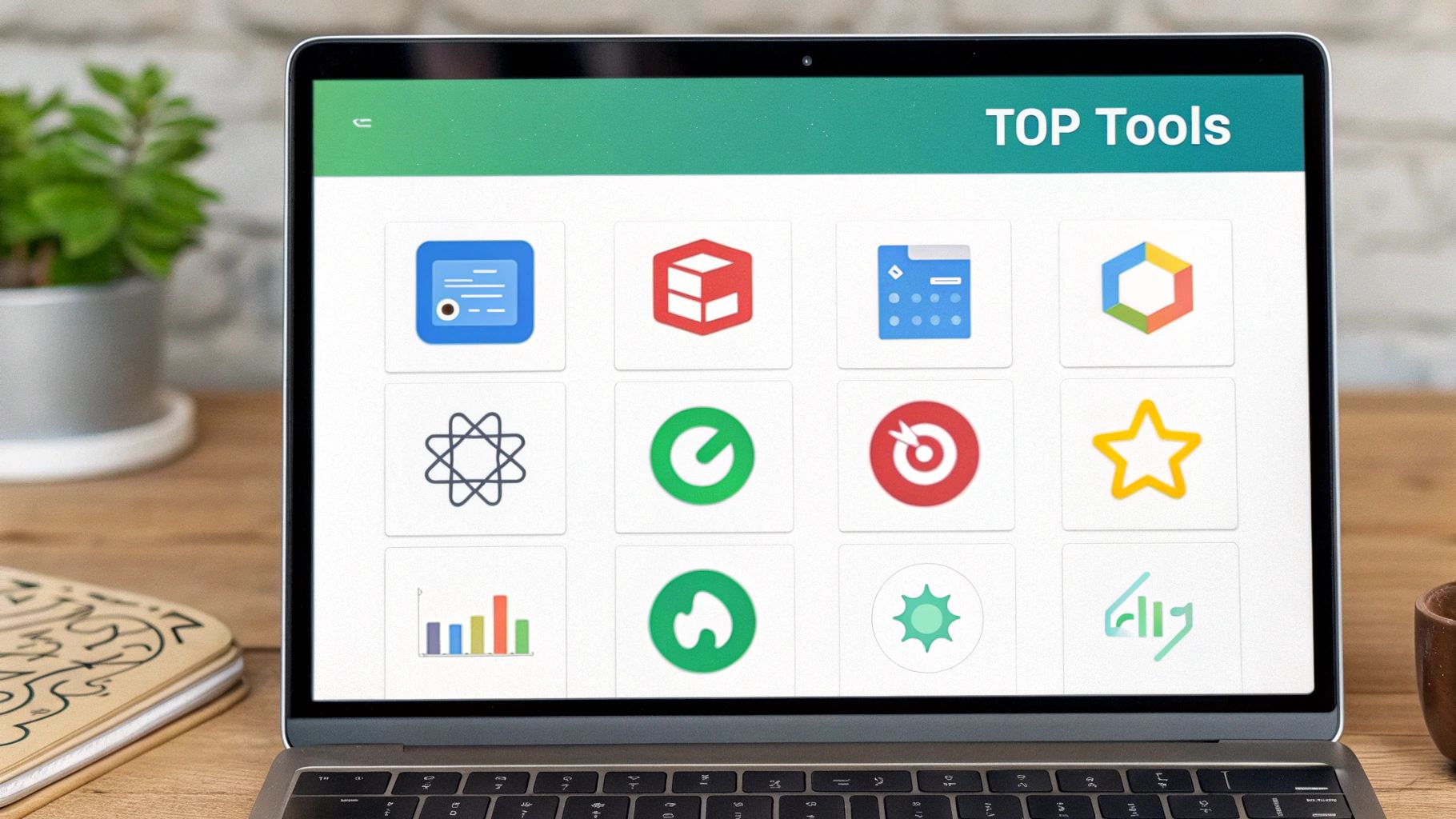Discover how a programming language converter modernizes code. Learn how these tools work, key use cases, and how to choose the right one for your project.
Think of a programming language converter as a master translator for your source code. It doesn’t just swap words; it intelligently rewrites an entire application from one language, like Python, to another, like Java, all while keeping the original logic and functionality perfectly intact.

It’s easy to think of code conversion as a simple, mechanical process. But that’s a bit like thinking a cheap translation app can capture the soul of a novel. A truly skilled human translator doesn’t just convert words; they understand the culture, idioms, and subtle nuances of both languages to ensure the final text carries the same weight and meaning.
That’s exactly what a good programming language converter does for code. It goes far beyond a simple find-and-replace on syntax. It has to deeply understand the logic, data structures, and core principles of the source language and then find the best, most natural-feeling equivalents in the target language.
This is a massive deal in modern software development, where tech stacks seem to change overnight.
The demand for these tools is exploding right alongside the software market itself. In 2024, the programming language market hit a valuation of around ****303 billion by 2029. What’s driving this? New frontiers like AI and the Internet of Things, which often need to connect shiny new platforms with battle-tested legacy systems.
Converters are the critical bridge making this possible, allowing code written decades ago to find a new lease on life on modern infrastructure. If you’re curious, you can explore additional details about these market dynamics to see why code conversion is such a hot topic.
The world of code translation has a few key players, and it’s easy to get them mixed up. While they all transform code, they do it for very different reasons. Let’s clear up the confusion between converters, transpilers, and compilers.
This table breaks down the core differences at a high level.
Essentially, a compiler translates code for a machine to understand. A transpiler translates code for a different environment (like a web browser). A converter, on the other hand, translates code for a human developer to maintain and build upon in a completely new language.
At its heart, a programming language converter is much more than a handy utility. For many businesses, it’s a powerful strategic asset. Here’s why:
So, how does a programming language converter actually pull off this trick? It’s not magic, but it’s close. The whole thing boils down to a sophisticated, three-step process that systematically takes code apart and puts it back together in a new language. This isn’t just a simple find-and-replace; it’s a structured approach that ensures the core logic—the very soul of the application—is kept intact.
Think of it like an architect tasked with modernizing a historic building. They don’t just slap a new coat of paint on it. First, they create a detailed blueprint of the original structure. Only then do they start designing the new one. A code converter follows a similar, careful path to translate between languages with high fidelity.
Everything kicks off with parsing. The converter acts like a detective, meticulously scanning every single line of your original source code. It looks at everything, from simple variable declarations to the most complex function calls. The goal here is to build a universal, language-neutral blueprint called an Abstract Syntax Tree (AST).
An AST is just a tree-like structure that maps out the code’s logical flow and hierarchy, completely stripped of its original syntax. For instance, a for loop in Python looks different from a for loop in Java on the surface. But under the hood, their AST representation captures the exact same idea: iterating over a list of items. This universal blueprint is the bedrock for the entire translation.
Next up is the most crucial stage: transformation. This is where the real intelligence of the tool comes into play. The converter takes that AST blueprint and starts remodeling it to fit the rules, structures, and best practices of the target language.
This involves mapping data types (like an int in one language to a number in another), restructuring control flows, and figuring out the right equivalent functions or methods. It’s far more complex than just swapping words because it has to account for fundamental differences in programming paradigms—like object-oriented versus functional—and the conventions of each language’s standard library.
With the transformed AST ready, the converter moves into the generation phase. It walks through this new, remodeled blueprint and writes out the final source code in the target language. The output is a complete, syntactically correct file (or set of files) that perfectly mirrors the logic of your original application.
This three-stage dance—parsing, transforming, and generating—is the engine that powers any effective programming language converter. This visual guide breaks down that workflow perfectly.

As the infographic shows, the converter takes the raw source code, turns it into a structured, intermediate blueprint, and only then produces the final output. It’s this separation of steps that allows these tools to tackle the incredible complexity of translating between entirely different programming languages.

It’s one thing to talk about the technical magic behind code conversion, but where does the rubber meet the road? The real power of a programming language converter isn’t just in the tech—it’s in the business impact. These aren’t just niche developer toys; they’re strategic tools for dragging old systems into the modern era, breaking into new markets, and getting internal teams to play nicely together.
By automating the grunt work of translation, these tools unlock serious value all across a company.
This isn’t a new idea, either. Converters and transpilers have been the unsung heroes of web development for years, helping us reuse code and make sure different systems can actually talk to each other. Their importance has only grown. Today, it’s estimated that up to 40% of new code commits in major repositories involve some form of code transformation.
Let’s dive into three real-world scenarios where code conversion makes a massive difference.
Picture this: a major bank is running its core transaction system on a COBOL application from the 1980s. It’s a workhorse, but it’s also a ticking time bomb. It’s hard to maintain, a security nightmare by today’s standards, and the number of developers who even know COBOL is dwindling fast. A full rewrite from scratch? We’re talking a multi-year, high-risk, wallet-busting project.
This is the perfect job for a programming language converter. By translating that battle-tested COBOL logic into something modern like Java or C#, the bank can hit several targets at once:
The converter does the heavy lifting, translating the core logic so the in-house team can focus on what matters: integration, testing, and building new features. It’s a smart, practical way to modernize without taking on a terrifying amount of risk.
Think about a successful mobile game company. Their hit app is only on iOS, written in Swift, and has millions of fans. That’s great, but they’re completely missing out on the gigantic Android market. Manually porting the game to Android using Kotlin would mean rewriting the whole thing. That’s double the development cost and a huge delay getting into a new market.
And this isn’t just for mobile apps. The same logic applies to moving desktop software from Windows to Mac, or shifting a web application from one backend framework to another. If you want to dig deeper into the mechanics, our guide on the role of a programming language translator is a great place to start.
Walk into any big tech company, and you’ll see different teams using different programming languages. It makes sense—use the best tool for the job. The data science team loves Python for its machine learning libraries, but the API team swears by Go for its raw performance. This “polyglot” environment is great for innovation but can be a real headache when it’s time to integrate.
Code converters act as the bridge between these language silos.
Let’s say the Python team cooks up a game-changing algorithm. Instead of trying to recreate it from scratch, the API team can use a converter to translate it into Go and plug it directly into their high-performance service. This means brilliant code gets shared and reused, not locked away in one team’s repository or wastefully rewritten.
Picking the right programming language converter is easily one of the most important calls you’ll make on a migration project. Get it wrong, and you’re left with a mess of buggy, unreadable code that’s an absolute nightmare to fix. But when you get it right? The right tool acts as a powerful force multiplier for your entire development team.
This isn’t about hunting for some mythical “best” tool. It’s about finding the one that truly fits your project’s complexity, your budget, and where you want to be in the long run. To do that, you need a solid framework for sizing up your options, whether you’re looking at a simple online script or a full-blown AI platform.
When you’re kicking the tires on a potential converter, zero in on four key pillars. Any tool that shines in these areas is far more likely to give you a smooth, successful conversion. And don’t just trust the marketing copy—run small but representative chunks of your own code through each tool to see how it actually handles a real-world test.
Your evaluation checklist should include:
To help you navigate the options, here’s a look at the different types of tools available and what they’re best suited for.
This table breaks down the main categories of converter tools. Use it to quickly see which type aligns best with the scale and needs of your project.
Ultimately, the table shows there’s no single solution for every problem. Your choice depends entirely on the task at hand.
The perfect programming language converter is the one that fits the job. A simple, one-off script conversion has totally different requirements than a massive, enterprise-wide modernization effort.
A basic online tool might be all you need to flip a single function from JavaScript to Python. For anyone tackling that specific task, understanding the nuances of a JavaScript to Python code converter is a great place to start.
But if you’re staring down the barrel of migrating a huge legacy system—one with tangled business logic and a web of dependencies—you need more firepower. This is where a powerful, AI-driven platform like DocuWriter.ai becomes the obvious choice. These advanced tools deliver the high accuracy and sophisticated handling of complex code that are absolutely critical for minimizing risk on big, important projects.
The next big leap for the programming language converter is happening right now, thanks to Artificial Intelligence. Think of traditional, rule-based converters as a very literal grammar textbook. They’re powerful, sure, but they operate with a kind of rigid logic that often misses the creative flair and idiomatic shortcuts that make a programming language feel alive. They follow instructions to the letter but can easily get tripped up by unique quirks or code that relies heavily on context.
AI-powered converters, especially those running on Large Language Models (LLMs), are a whole different ballgame. Instead of just applying a fixed set of rules, these tools are smart enough to read and understand the intent behind the code. It’s the difference between a clunky, word-for-word translation and one done by a skilled human interpreter who gets the cultural nuances.
An AI converter doesn’t just look at one line at a time. It analyzes the code as a whole, having learned from countless real-world software projects. This training allows it to generate code that isn’t just syntactically correct, but also idiomatic and easy to maintain. The final output feels natural to a developer who knows the target language inside and out, because it follows all the familiar conventions and best practices.
This deeper, contextual understanding brings some serious advantages to the table:
The growth of AI has also fueled the development of sophisticated AI code generators, which are becoming key players in both creating new code and executing these advanced conversion techniques.
This AI-driven method turns a programming language converter from a simple utility into an intelligent partner for modernization. This is exactly how platforms like DocuWriter.ai are able to deliver such impressive results on complex migration projects.
This screenshot from DocuWriter.ai shows just how simple the process can be. You just paste your source code, pick your target language, and let the AI do the heavy lifting.

The clean interface really drives home the mission: to simplify a historically painful process and make top-tier code conversion accessible to everyone. It gives development teams the confidence and speed they need to take on ambitious modernization goals without breaking a sweat.
Just having a powerful programming language converter isn’t a magic bullet for a successful migration. The other, more critical, part of the equation is a smart, methodical strategy. A well-planned project gets the most out of your tools and helps you sidestep the kind of unexpected roadblocks that can derail everything. It’s the difference between a chaotic scramble and a predictable, manageable process.
Think of an automated converter as a brilliant junior developer. It’s incredibly fast and can handle a massive amount of the grunt work, but it doesn’t have the seasoned intuition of a senior engineer. The code it produces still needs a guiding hand. That’s why budgeting time for your senior developers to manually review and refactor the output isn’t just a nice-to-have—it’s essential for a high-quality result.
The real work starts long before you ever click “convert.” You’ll find that a clean, well-structured codebase always produces a much cleaner result on the other side.